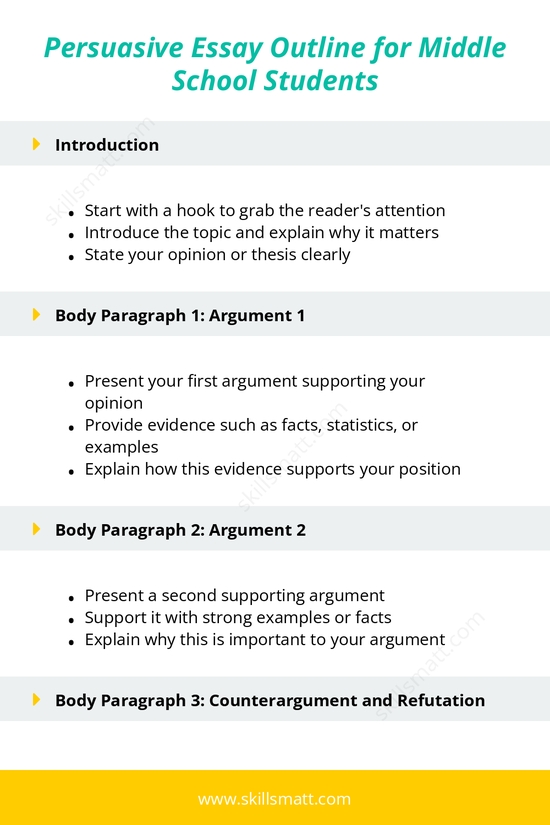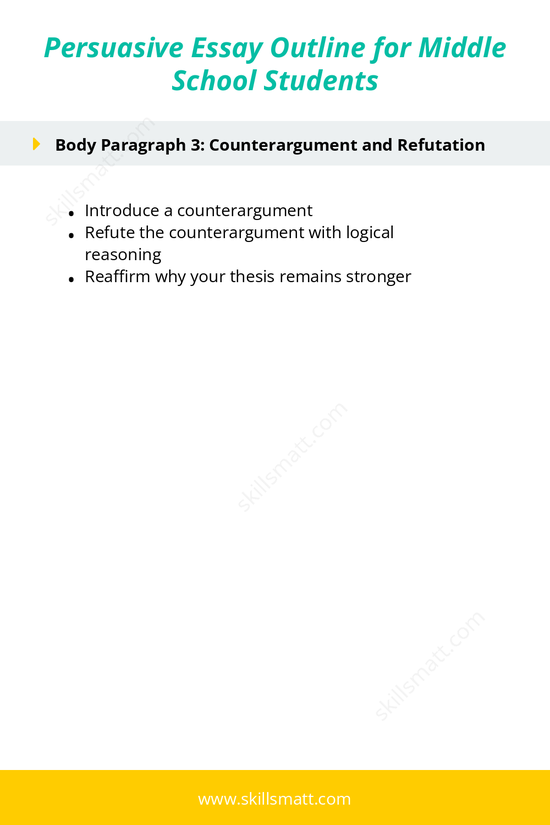Writing a persuasive essay can be a fun and rewarding way for middle school students to express their opinions on a particular issue. The goal of a persuasive essay is to convince the reader that your point of view is valid by using logical arguments and evidence. The following outline will guide you through each step of the essay, helping you structure your thoughts and present your arguments effectively.
Introduction
The introduction of your persuasive essay should capture the reader's attention and clearly state your opinion or thesis. It sets the stage for the rest of the essay, so it’s important to make it compelling.
- Start with a hook to grab the reader’s attention: Begin with an interesting fact, a question, or a bold statement that piques the reader's curiosity.
- Introduce the topic and explain why it matters: Let the reader know what you are writing about and why it’s important. Give a little background information to help them understand the issue.
- State your opinion or thesis clearly: In the last part of the introduction, clearly state your position on the topic. This is your thesis, which you will argue throughout the essay.
Body Paragraph 1: Argument 1
The first body paragraph presents your strongest argument supporting your opinion. This is the first reason you believe your position is the right one.
- Present your first argument supporting your opinion: Start with a clear topic sentence that introduces your first argument. For example, if your essay is about the importance of recycling, your first argument might be that recycling reduces waste in landfills.
- Provide evidence such as facts, statistics, or examples: Back up your argument with solid evidence. This could include real-life examples, statistics, or facts from reliable sources.
- Explain how this evidence supports your position: After presenting your evidence, explain why it is important and how it strengthens your argument. Show the reader how this evidence backs up your thesis.
Body Paragraph 2: Argument 2
The second body paragraph introduces another strong reason that supports your thesis. This argument should further reinforce your position.
- Present a second supporting argument: Present your second reason for believing your thesis. If your essay is about school uniforms, for instance, your second argument could be that uniforms promote equality among students.
- Support it with strong examples or facts: Provide evidence, such as studies, examples from other schools, or expert opinions, to support your second argument.
- Explain why this is important to your argument: Connect this evidence to your thesis. Explain why this argument matters and how it adds weight to your position.
Body Paragraph 3: Counterargument and Refutation
In this paragraph, you acknowledge an opposing viewpoint and show why your argument is stronger. Addressing counterarguments demonstrates that you have considered different perspectives and strengthens your position.
- Present the counterargument: Introduce the opposing viewpoint to your thesis. This might be a common argument that challenges your position.
- Refute the counterargument: Show why this opposing viewpoint is not as valid or strong as your argument. You can use evidence, logic, or reasoning to explain why your position holds more weight.
Conclusion
The conclusion should summarize your main points and restate your thesis in a compelling way. It’s your last chance to persuade the reader, so make it count.
- Restate your thesis: Reaffirm your opinion or thesis in light of the arguments you presented in the body paragraphs.
- Summarize the key arguments: Briefly recap your strongest points to remind the reader of your evidence.
- End with a call to action or thought-provoking statement: Conclude by encouraging the reader to think critically about the issue or take some kind of action based on your argument.


